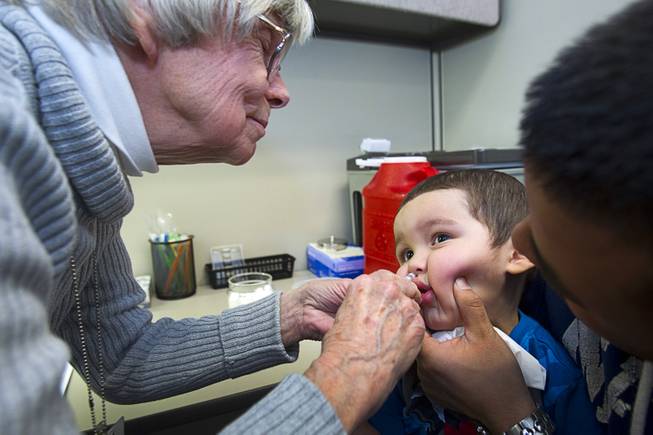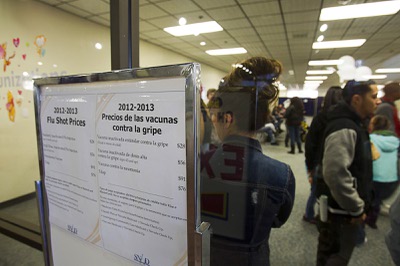
Nurse Ella Duhaime give a FluMist vaccine to Jose Menchaca, 2, at the Southern Nevada Health District, 330 S. Valley View Blvd., on Monday, Jan. 14, 2013. The FluMist vaccine is a needle-free vaccine in the form of a nasal spray.
Tuesday, Jan. 15, 2013 | 2 a.m.
Avoiding the flu
- • Wash your hands often.
- • Flu is a virus that can rapidly spread in a dry environment. A humidifier or otherwise moistening your environment can help decrease the risk.
- • Sunshine also helps kill flu germs, so open your drapes, blinds or shutters to let the sun shine into your home.
- • This is a time when sharing isn't necessarily positive — don't share glasses or silverware.
- • When using a disinfectant, make sure the label indicates it will kill influenza (even though the picture or label may reference one specific flu, for "killing purposes" they will work on all the flu strains).
- • Be creative when disinfecting surfaces — phones, keyboards, steering wheels, car keys, door handles, desktops, kitchen counters or anywhere else in your family's "sneeze zone."
Sun coverage
- Key Things to Know About This Flu Season (01-13-2013)
- How to tell a cold from the flu (01-13-2013)
- Late scramble for vaccine as flu season heats up (01-13-2013)
- Flu cases on rise in Nevada, health officials say (01-10-2013)
Nevada so far has been spared from a flu outbreak that hit much of the nation earlier than expected. But with temperatures dipping below 30 degrees, Clark County students returning to school last week and UNLV’s campus starting a new semester this week, local health officials are on the lookout for a spike.
For the week of Dec. 30 to Jan. 5, the federal Centers for Disease Control and Prevention reported that 9 of the 10 regions it monitors reported higher-than-normal outpatient visits for flu-like symptoms. The only area that was showing normal rates was the region that includes Nevada, Arizona, California, Hawaii and Guam.
Influenza hit epidemic proportions in some regions in the final weeks of 2012. Flu cases are up threefold from last year in New York, for example. CDC data shows influenza diagnoses nationwide spiked at the end of December and have dropped in early 2013. In the second-to-last week of 2012, there were 5,417 confirmed cases of influenza, and that number dropped to 4,222 in the first week of 2013.
In 2011, the Southern Nevada Health District reported 459 cases of the flu. The district reported 397 cases in 2012. The numbers come nowhere near the 2009 outbreak, in which the H1N1 strain swept the nation with fevered chills, muscle aches, stuffy noses and worse. That year, Southern Nevada reported 5,557 cases of the flu; there were an estimated 61 million cases nationwide, according to the CDC.
“It's clear that influenza is here. It has finally arrived,” said Brian Labus, senior epidemiologist for the Southern Nevada Health District. “It had arrived on the East Coast earlier, but it’s getting here now. There has been an increase in cases, but nothing out of the ordinary here.”
Labus said the vaccine has matched well with the strains of the influenza virus that health officials are seeing in Nevada and nationally. There have been no shortages of the vaccine reported in Southern Nevada.
“We recommend the vaccine for everybody, especially the youngest and oldest in the population. We also try to focus on people with serious underlying health problems,” Labus said.
Although hospitals in the valley have not seen a crush in flu patients, they are getting prepared.
Spring Valley Hospital has set up a special tent for patients in anticipation of a flu outbreak. The tent, part of the Las Vegas Valley's Metropolitan Medical Response System, is available upon request from the city of Las Vegas and will be used for overflow patients with various illnesses, not just the flu.
The Valley Health System, which operates five hospitals throughout Southern Nevada, has seen 20 confirmed cases of influenza since Jan. 1, spokeswoman Gretchen Papez said. The tent, which is heated, is ready to take patients but has not been needed yet.
“I think we are going to see a surge here coming up behind the South and East, partly because of the weather,” said David Woodard, Valley Health System infection control director. “It just got real cold, and that contributes to the ability of the virus to spread. Kids were still out of school until recently, so the closeness hasn’t occurred yet that can allow for the spread of the virus.”
The Clark County School District has been spared any waves of flu-related absences so far, said Melinda Malone, a district spokeswoman.
“At this time of year, they emphasize the importance of washing your hands to the children, and we tell parents to monitor their children and keep them home if they are showing any symptoms,” Malone said. “We teach the kids the ‘vampire cough’: you know, sneezing or coughing into their shoulder or arm.”
Assisted-living facilities contacted throughout the valley indicated they also have dodged major outbreaks so far this season. The residences for the elderly all said they had arranged immunization clinics early in the fall for their residents to make the vaccine as accessible as possible.
B.J. Wright, marketing director at Heritage Springs, said only one resident had come down with the flu, and he currently is in the hospital.
“We take all kinds of precautions,” Wright said. “We put informational fliers up everywhere. We ask our housekeepers to disinfect more widely, including wiping off doorknobs and wiping down elevator buttons. We wipe down pens and countertops. We want to prevent even just one case because we are dealing with a vulnerable population here. This is a close-knit community, and if one person gets it, it can easily spread.”
Cold temperatures do not directly lead to contracting the influenza virus, but they do keep more people indoors and in close quarters. When someone suffering from influenza coughs or sneezes, droplets containing the virus are released into the air. Healthy people contract the virus by inhaling the droplets or by touching a contaminated object (doorknob, faucet, pen, etc.) and then touching their eyes, mouth or nose.
Children younger than 2, adults older than 65, pregnant women and people with certain chronic medical conditions such as emphysema, asthma and diabetes are considered to be at risk for serious complications from the flu.
For more information on the influenza vaccine, contact your primary care physician or the Southern Nevada Health District’s immunization clinic at 759-0850.


Join the Discussion:
Check this out for a full explanation of our conversion to the LiveFyre commenting system and instructions on how to sign up for an account.
Full comments policy